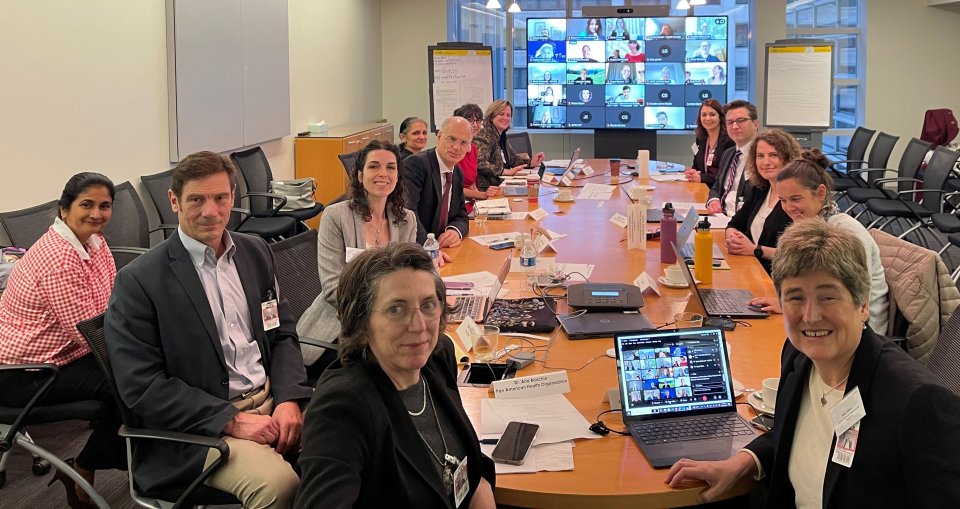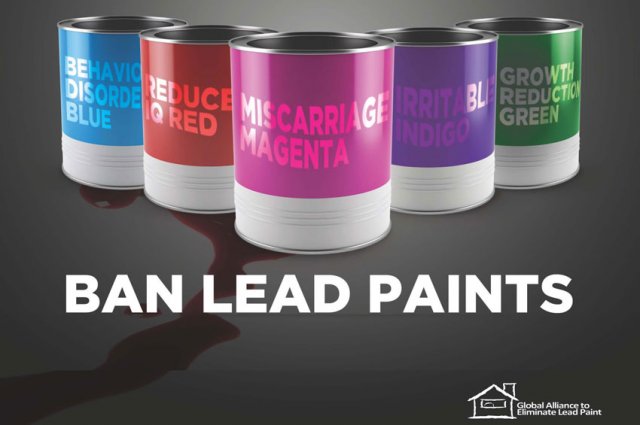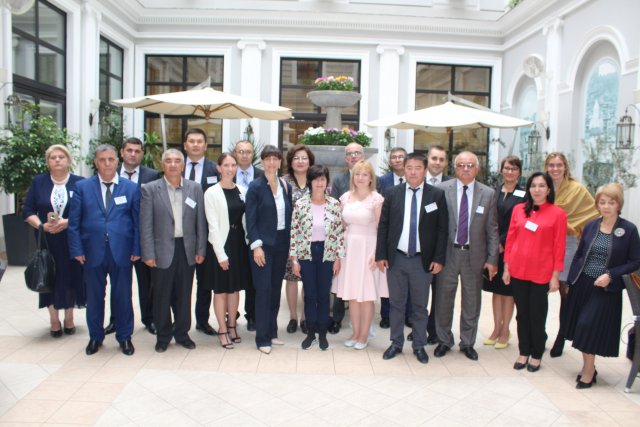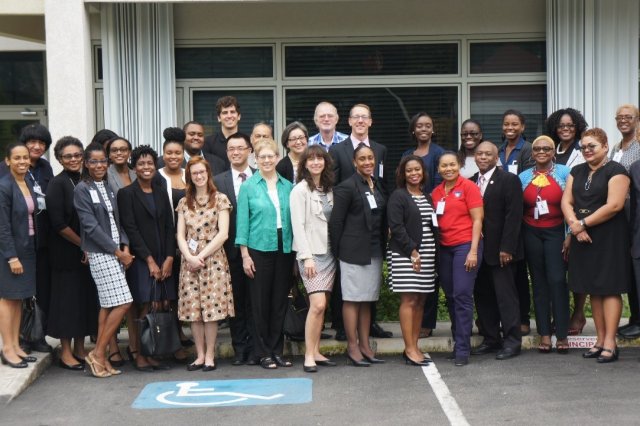EPA International Cooperation on Lead Pollution
- founding member of the Partnership for a Lead-Free Future;
- signing a Memorandum of Understanding with the U.S. Agency for International Development;
- co-chairing with US AID the US Government International Exposure Working Group;
- conducting a project with the United Nations Environment Program (UNEP) on lead in Africa;
- organizing lead expert webinars for G7 and G20 members;
- working with ASTM on a new standard for X-Ray Fluorescent analyzer testing of lead in paint; and
- leadership in the Global Alliance to Eliminate Lead Paint.
- Resources for International Cooperation on Lead
- Key Milestones for EPA's International Lead Cooperation Program
G7 and G20

Federal Government's International Lead Exposure Working Group
Partnership for a Lead-Free Future
EPA and U.S. Agency for International Development Memorandum of Understanding
United Nations Environment Programme Africa Project
EPA Leadership in Lead Paint Alliance

EPA is also working internationally to assist other countries to establish laws to protect children and consumers from lead-containing paint. Just under 100 countries still allow the manufacture and sale of paint with high levels of lead; most of them are low- and middle-income countries. Building on the success of phasing out lead in gasoline globally, EPA is working through a multi-stakeholder, international partnership called the Global Alliance to Eliminate Lead Paint or Lead Paint Alliance (see below) to provide individual countries with guidance on drafting strong and effective laws to regulate lead-based paint.
The Global Alliance to Eliminate Lead Paint ("Lead Paint Alliance" or "the Alliance") is a voluntary collaborative partnership of governments, private industry, and NGOs that works to promote the phase-out of the use of lead in paint. The Lead Paint Alliance was established in 2011 and the United Nations Environment Programme (UNEP) and the World Health Organization (WHO) serve as the joint secretariat. U.S. EPA is the Chair of the Advisory Council of the Lead Paint Alliance, which includes representatives from each of the major stakeholders in the Alliance and governments from each UNEP lower- and middle-income region.
The goal of the Alliance is to prevent children’s exposure to lead via paints containing lead, particularly those in countries where lead paint is still manufactured and is commonly used. The main objective of the Lead Paint Alliance is to promote the establishment of lead paint laws globally. The U.S. banned lead in paint in the 1970s and is providing technical and policy expertise to developing countries to put in place lead paint laws. Governments, private industries, and NGOs can support this goal by becoming a partner of the Lead Paint Alliance.
U.S. EPA supports the goal of the Alliance by providing expertise and leadership in the development of programs, reports, tools to establish laws, and awareness raising efforts, such as those noted below under “Resources for International Cooperation on Lead.”
ASTM Collaboration on an XRF Standard for Lead in Paint
EPA is working with ASTM International and Mercer University on a proposed new standard for testing for lead in manufactured or imported paint using X-Ray Fluorescent Analyzers (XRF). XRF allows for rapid, cost-effective analysis of new paint samples and it can support the conformity assessment of paints to ensure they meet the low lead limits established in lead paint regulations in LMICs. The standard is expected to be approved in 2025.
- Resources for International Cooperation on Lead
- Key Milestones
- About Lead Paint
- About the Lead Paint Alliance
Resources for International Cooperation on Lead
The following links exit the site.
Partnership for a Lead-Free Future
- Dr. Jill Biden remarks at the PLF Launch at the UN General Assembly
- UNICEF UN General Assembly Launch event
- US AID Lead-Free Future website
Information on International Lead Sources
- World Health Organization Website - Lead poisoning
- Institute for Health Metrics and Evaluation Website - Lead exposure – Level 3 risk
- UNICEF Toxic Truth Report
- Larsen, B., E. Sanchez-Triana (2023). Global health burden and cost of lead exposure in children and adults: a health impact and economic modelling analysis. Lancet Planetary. Volume 7. Issue 10. E831–840.
Lead Paint Alliance
- Official website of the Lead Paint Alliance, including recent newsletters
- Become a partner of the Lead Paint Alliance
Discussions and Presentations
- Towards a Coordinated, Multi-Sectoral Lead Management Approach in Low- and Middle-Income Countries: UNEP Consultations in the Africa Region (Part I), July 2024
- Discussions on the Lead in Paint Community of Practice 2020-2024
- Overview of the Model Law and Guidance for Regulating Lead Paint, May 2024
- ASTM International Webinars on Lead Paint Testing, September 2022
- Presentations and report from Webinar for Policymakers on Eliminating Lead in Paint through Regulatory Action, Oct 2020
- Presentations and report from Webinar for the Paint Industry on Eliminating Lead Paint, Nov 2020
Tools to Establish Laws on Lead in Paint
- Lead Paint Law Compliance and Enforcement Guidance
- Lead Paint Reformulation Technical Guidelines
- Lead in Paint Laboratory Database (UNEP)
- Suggested Steps For Establishing a Lead Paint Law
- Model Law and Guidance for Regulating Lead Paint
- Toolkit for Establishing Laws to Control the Use of Lead in Paint
- Updated Brief guide to analytical methods for measuring lead in paint (WHO)
Tracking Status of Laws, Paints and Impacts
- Database and map of regulations and controls on lead paint (WHO)
- Map of Lead Levels in Paint Around the World (from Lead Paint Alliance partner IPEN)
Awareness and Advocacy
- Annual International Lead Poisoning Prevention Week (ILPPW) Campaign Website (WHO)
- Guidance on advocacy and awareness-raising (WHO)
- Policy Brief and Technical Brief on Global elimination of lead paint: why and how countries should take action (WHO)
- Video: Lead Paint Alliance: Ban Lead Paint
- Video: Strategic Approach to International Chemicals Management (SAICM): Lead in Paint: Emerging Policy Issue
- Video: Chemicals & waste management: Overview of the Inter-Org. Prog. for the Sound Management of Chemicals, featuring EPA staff on lead paint
Key Milestones

October 2024: ASTM announces new work program on standard for XRF for lead paint testing.
October 2024: EPA and UNEP
October 2024: EPA played an active role in the 121th annual International Lead Poisoning Prevention Week. Learn more about our activities each year since 2013 in this campaign.
September 2024: EPA joins the Partnership for a Lead-Free Future at the 79th UN General Assembly.
July 2024: EPA and the United Nations Environment Programme organized an online webinar as the first of two consultations on lead sources and management in African countries.
March 2024: EPA and the U.S. Agency for International Development signed a memorandum of understanding to cooperate on reducing pollution, including providing support to low- and middle-income countries to enact and enforce binding regulation to curtail lead in paint, spices, and cosmetics.
November 2023: EPA organized the G7 Expert Meeting on Concrete Actions to Address Lead Pollution and Exposure in Low- and Middle-Income Countries with the EU and German Environment Ministry and developed a visioning document for opportunities to reduce exposure to lead paint and other lead sources.
October 2023: EPA played an active role in the 11th annual International Lead Poisoning Prevention Week. Learn more about our activities each year since 2013 in this campaign.
March 2023: EPA led the development of the UNEP Lead Paint Law Compliance and Enforcement Guidance, which outlines actions governments can take to foster compliance, as well as actions companies can take to document compliance, in order to support governments establishing and implementing lead paint laws.
October 2022: EPA played an active role in the 10th annual International Lead Poisoning Prevention Week. Learn more about our activities each year since 2013 in this campaign.
September 2022: EPA co-sponsored ASTM International Webinars on Lead Paint Testing.
December 2021: EPA spearheaded the drafting and design of WHO's Global Status Update of Legal Limits on Lead in Paint.
October-November 2020: EPA moderated the UNEP webinar for policymakers on October 5, 2020, and led the development of the agenda and content of the UNEP webinar for industry on November 19, 2020.
September 2019: EPA participated in a Department of Commerce-sponsored Lead Paint Elimination Workshop for the Central and Eastern Europe and Central Asian Region in Tbilisi, Georgia on September 11-12, 2019.
March - August 2019: EPA participated in four regional lead paint workshops organized by UN Environment as part of the Lead in Paint component of the SAICM Global Environment Facility (GEF) project, “Global best practices on emerging chemical policy issues of concern under the Strategic Approach to International Chemicals Management (SAICM)":
- Asia Pacific Regional Lead Paint Workshop in Bangkok, Thailand
- Latin America and the Caribbean Regional Workshop on Lead Paint in Panama City, Panama
- Africa Regional Workshop on Lead Paint in Abidjan, Cote d’Ivoire
- Central and Eastern Europe Regional Workshop in Lead Paint in Almaty, Kazakhstan
Follow up to the workshops includes identification of steps in each country to establish lead paint laws. Meeting reports and presentations from each workshop are available on the website of the SAICM GEF project.
December 2017: Environment ministers from around the world signaled support of lead paint laws by passing a lead paint resolution at the Third United Nations Environment Assembly (UNEA-3).
December 2017: EPA participated in the Caribbean Workshop on the Establishment of Legal Limits on Lead in Paint, which had 38 attendees, representing more than 20 organizations and agencies from the public, private, and civil sectors.

August 2017: The American Bar Association passed a resolution encouraging its members to support adoption and implementation of laws to phase out and eliminate lead paint through pro bono support, educational initiatives, and other appropriate means.
- View ABA Resolution and Report on Lead Paint (19 pp, 350 K, About PDF)
May 2017: At the 70th World Health Assembly, health ministers approved action on lead paint in a Chemicals Roadmap.
About Lead Paint

Lead exposure is a well-known source of injury to human health, particularly to the health of children and to workers in lead industries. No level of exposure to lead is considered safe. Children exposed to high levels of lead may experience sensory, motor, cognitive and behavioral impacts, including learning disabilities; attention deficits; disorders in coordination, visual, spatial and language skills; and anemia.
Using leaded paint creates potential lead poisoning problems for the future. Most poisoning from lead paint occurs when infants and children ingest the dust of old lead paint as it deteriorates of chips off surfaces. Thus, lead paint poses a health risk long after the initial painting is done. That is why we want to work together to make sure that no paints contain lead.
Alternatives to lead paint already exist. Although lead paint is still produced and sold in many countries around the world, a simple, cost-effective alternative exists. Paints without added lead are as effective and economically competitive as their lead counterparts. In fact, a nine-country study published by UNEP and the NGO IPEN showed that in many places where lead paint is sold, lead free alternatives exist for similar prices. Recent paint testing (52 pp, 3M, About PDF)also shows that paints with low levels of lead are available in developing countries. Additionally, work to conduct pilot demonstrations of paint reformulation in small paint companies showed that it is feasible to reformulate paint to contain non-lead ingredients.
About the Lead Paint Alliance
The U.S. EPA is an active member, and Advisory Council Chair, of the Global Alliance to Eliminate Lead Paint. The Lead Paint Alliance is a global partnership of Governments, private industry, and NGOs that works to promote the phase-out of the use of lead in paint.
The work of the Lead Paint Alliance includes raising awareness of the dangers lead poisoning poses to human health; and helping developing countries build regulations to stop the manufacture, import, and sale of paints containing lead.
The Lead Paint Alliance promoted the establishment of lead paint laws globally partially through the Lead in Paint component of the SAICM Global Environment Facility (GEF) project “Global best practices on emerging chemical policy issues of concern under the Strategic Approach to International Chemicals Management (SAICM)." This project worked with governments to help establish laws and with industry to help promote reformulation of lead paint. Current efforts are building on lessons learned and progress made during this project.
As Chair of the Lead Paint Alliance Advisory Council, U.S. EPA is working to help make other nations aware of the dangers of lead paint and ways to address this problem. The Global Alliance is focusing its efforts on helping countries without existing lead paint laws put effective legislation/regulations in place.
The Alliance is a led by a joint secretariat of the United Nations Environment Programme (UNEP)and the World Health Organization (WHO). It was established at the International Conference on Chemicals Management at its second session (ICCM2) as one initiative to implement the Strategic Approach to International Chemicals Management (SAICM).
This initiative promotes the implementation of paragraph 57 of the Plan of Implementation of the 2002 World Summit on Sustainable Development (PDF) , which states: to phase out lead in lead-based paint and in other sources of human exposure, work to prevent, in particular, childrens exposure to lead and strengthen monitoring and surveillance efforts and the treatment of lead poisoning.
Contacts
For additional information on EPA's work on international cooperation on lead, contact:
Angela Bandemehr
U.S. Environmental Protection Agency
Office of International and Tribal Affairs (2670R)
1200 Pennsylvania Ave., NW
Washington, DC 20460
E-mail: [email protected]
(202) 564-1427
